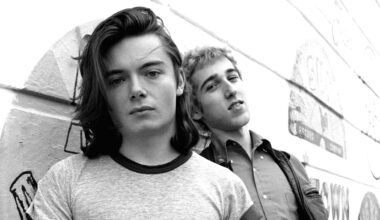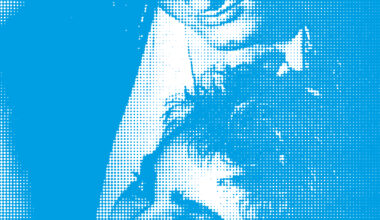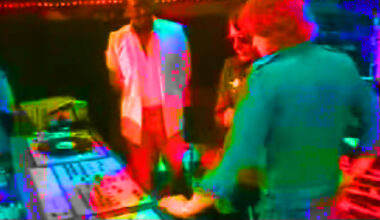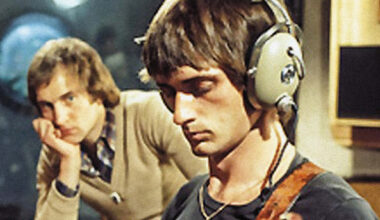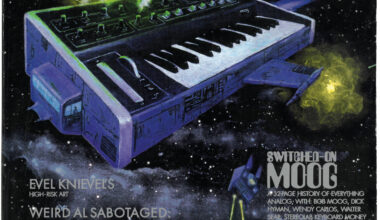In 1995, a new music magazine catapulted underground electronic music into the mainstream. To mark 20 years since the first issue of MUZIK, we track down its founders to tell the full story (although it wasn’t that hard to find them)
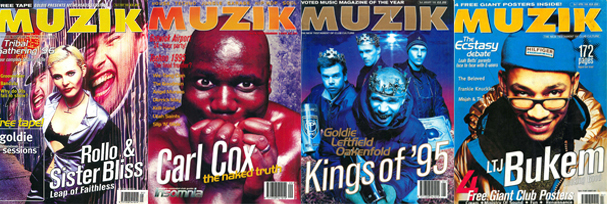
Every now and again, an idea comes along that changes things. Twenty years ago this month, a new music magazine appeared on the newsstands that did just that.
In 1995, Muzik was a breath of fresh air for those who’d grown up with electronic music humming in their ears. An on-the-money publication with intelligent writing and great photography, Muzik had a further trick up its sleeves in that it treated electronic music with the same irreverence employed by the rock press. Which wasn’t surprising seeing as the two guys at the helm, editor Push and deputy editor Ben Turner, were from IPC’s legendary music weekly, Melody Maker.
To tell the story of how the whole thing came about, we need to cast back to 1988.
“There were a few of us writing about acid house at the time,” says Push, who wasn’t difficult to find seeing as these days he sits in the editor’s chair at Electronic Sound. “Melody Maker was quick off the mark, but the next week they’d be back to sticking The Cure on the cover again.”
Frustrated with the ongoing struggle for regular electronic music coverage, a group of writers – Push, Andrew Smith, Bob Stanley (later of Saint Etienne) and Cosmic Cowboy (aka Kiss FM DJ Dave Mothersole) – went to then-editor Allan Jones and suggested a dance music section. To their surprise he agreed and the paper’s Stone Free pages were born.
Stone Free lasted a couple of years until IPC decided, on the back of a readers’ survey that offered Guns N’ Roses videos as a prize, that no one was interested in electronic music and the section was scrapped. So it was back to fighting for space in the Maker’s main pages again. But the dance music guys were about to get a new ally.
“I did work experience for a week at Melody Maker when I was 16,” says Ben Turner, joining the story down the line from Boston where he’s on the CNTRL educational tour with Ritchie Hawtin, who he manages. Ben landed a summer job at the Maker, after which he was offered a full-time gig on the picture desk. With it came the chance to cut his teeth as a writer.
“I got sucked into electronic music very quickly and soon discovered that only Push and a couple of others had any idea what I was talking about,” says Ben. “I started writing a little column called Twilight Zone, where I’d rant and rave about DJs and all the amazing music they were playing. To us, that was as exciting as watching any band.”
In early 1994, things changed again when Underworld appeared on the cover of Melody Maker. Push wrote the feature and Ben penned the album review. The same issue, flagged as a dance music special, also featured Aphex Twin, Orbital, The Orb and The Drum Club, and the following week saw the relaunch of the dance music pages. Rechristened Orbit and edited by Push and Ben, the section quickly gained a reputation for having its fingers on the pulse, which in turn saw Belgian independent techno label R&S Records book a run of double-page adverts.
“No one apart from us had even heard of R&S,” says Ben. “It was at that point IPC thought, ‘Hang on a minute, why are these people spending money in a rock music paper?’.”
All roads led to Orbit and it wasn’t long before Push and Ben were asked to look at producing a stand-alone title. With Orbit now established as the Maker’s dance music pages, they needed an alternative title for the new magazine.
“We had endless meetings trying to come up with a name,” sighs Push. “We settled on Muzik because it seemed a bit futuristic and it opened up the opportunity for us to not be a dance music magazine down the line. It was always meant to be about dealing with whatever was the latest exciting thing. It was only once we’d launched we realised we had a problem because when you said the title, especially on the phone or on the radio, you always had to say ‘Muzik – with a Z and a K’.”
The first issue was published in May 1995 with The Chemical Brothers on the cover. It was also the Chemicals’ first magazine cover. In the hands of photographer Vincent McDonald, two ordinary looking blokes who happened to make the most block rocking of beats were transformed into dynamic, vibrant, cartoon-like characters springing off the newsstand. These days, making a decent fist of Photoshop is par for the course. Back then, when cameras still used film, what Vincent did each month on the front page of Muzik was more than impressive. Alongside the Chemicals, other early covers featured Daft Punk morphed into green frogs on lily pads (also Daft Punk’s first magazine cover) and a naked Carl Cox painted red brandishing a water pistol.
“The front covers were hugely important,” believes Ben. “We were treating underground artists such as Dave Clarke like proper stars. We had a very reactive audience and it was great to see that we could help artists sell records. I was obsessed with making sure we were so on the money that you couldn’t not buy this magazine if you wanted to know what was going on. I still get emails to this day saying ‘Muzik was my education’.”
It was an education for the staff too. The team, which I joined as a rooky sub editor a few issues in, was small. Alongside Push and Ben, there were two designers, a staff writer, a production editor, two subs and an editorial assistant. Issues were often close on 200 pages and overflowing with content. It wasn’t uncommon to pull all-nighters, not in a clubbing sense, but sat in the office trying to finish the issue before the presses rolled.
“It was bit unorthodox,” admits Ben. “I was this sort of roving reporter who brought stuff back to the office and Push would pieced it all together perfectly. We had people above us trying to get us to do things in a more traditional magazine way, but we were supposed to be slightly counter-culture. We would be trying to cram 500 words into a space that would usually only have 250. It’s mind-blowing when you look at how much we jammed into one issue.”
“On about issue three or four, I remember walking to work one morning thinking, ‘I don’t know how much longer I can do this’,” laughs Push of the full-tilt production schedule.
Muzik didn’t so much outgrow their first office, on the 25th floor of IPC’s King’s Reach Tower alongside NME and Vox, as get kicked out due to the constant dialled-up thud of dance music. Their new home was over the road, in Hatfield House, in an office next door to Loaded magazine, which IPC had launched a few months before Muzik.
“A lot of our madness was out and about,” says Ben. “We were actually quite studious in the office, we got our heads down to get the magazine out, while at Loaded it was utter chaos. There was always a party going on next door. I think they all thought we were really boring.”
The Muzik staff were anything but boring. Rob Da Bank began his career there. Arriving on a week’s work placement, he carved out a job for himself running the massive club listings. Other notables who started at Muzik were future Dazed & Confused editor Rachel Newsome, double Mercury Award winning Big Dada label boss Will Ashon, and no-nonsense tabloid journalist Sonia Poulton, while the writers also included Terry Farley, Kris Needs, Bob Jones, Spoony and Slipmatt. The magazine’s tech editor was Electronic Sound deputy editor Mark Roland.
“Calvin Bush was the funniest one,” says Ben of the magazine’s unpredictable staff writer. “He was writing for us at Melody Maker before Muzik and one night we were at Sabersonic, really drunk, and he whispered in my ear, ‘You do know I write for NME under another name’. I couldn’t fucking believe the front of this guy. I don’t think anyone else ever pulled that off. There were always moments with Calvin around, but he was a brilliant writer.”
The title oozed attitude, with provocative features on everything from aliens in dance music to DJ groupies, from the Black Panthers to city boy ravers. And, of course, it treated the dance music cognoscenti with the same irreverence that guitar bands were well used to in the pages of Melody Maker.
“It wasn’t about patting everybody on the back, it was about having a proper critical approach,” explains Push. “Ben and I were both schooled in the Melody Maker way and that was to take the piss. It was about having an attitude and being ballsy about it. It was difficult because a lot of people we covered struggled with that.”
Regular features such as Hang The DJ, where each month an artist would be “strung up for crimes against music”, caused much angst.
“I used to spend hours on the phone apologising, or pre-empting stuff that was coming out,” recalls Ben. “I remember sitting in a hotel in Liverpool one morning with Paul Oakenfold and he just let rip at me. It was really quite awkward. We did this little section called Double Egg and we’d put Paul’s picture next to a picture of Fred West. We weren’t saying he looked like a serial killer, but he happened to look like a man who was. Paul couldn’t understand it. There are so many things like that, we were continually poking fun at the people we kind of idolised, but it was all done in a very tongue-in-cheek way.”
“The Chemical Brothers got upset about the cover feature I wrote,” recalls Push. “They were very critical of the dance music scene during the interview, and they were bloody right in what they were saying, but I don’t think they expected me to put it all in the feature. We launched the magazine at the 1995 Tribal Gathering, which was where Tom and Ed saw the article for the first time. They were so furious about what I’d written, they threw the mag on the floor and stamped all over it.”
IPC closed Muzik in August 2003, by which time Push and Ben had long moved on, but those early issues remain shining examples of what a good music magazine should be. So what do they consider to be Muzik’s legacy?
“We shone a light on music that wasn’t being championed anywhere else,” says Ben. “The conversation I often have now is about the lack of a single influential voice today. You have to go to 15 different places to get any sense of anything. I think that’s a real problem for electronic music as a whole, it doesn’t have a focus anymore.”
“Muzik helped people realise that electronic music should be taken seriously,” says Push. “But perhaps the single most important thing we did was we took faceless dance music and gave it a face. Muzik talked seriously about the music, but it was also interesting and provocative and funny. And you know what? I think we nailed it.”
